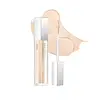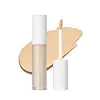What's inside
What's inside
 Key Ingredients
Key Ingredients

 Benefits
Benefits

 Concerns
Concerns

 Ingredients Side-by-side
Ingredients Side-by-side

Water
Skin ConditioningCyclopentasiloxane
EmollientCI 77891
Cosmetic ColorantMethyl Methacrylate Crosspolymer
Trimethylsiloxysilicate
EmollientPEG-10 Dimethicone
Skin ConditioningIsododecane
EmollientButylene Glycol
HumectantGlycerin
HumectantPentaerythrityl Tetraethylhexanoate
EmollientPentylene Glycol
Skin ConditioningCetyl PEG/PPG-10/1 Dimethicone
EmulsifyingCI 77492
Cosmetic ColorantDisteardimonium Hectorite
StabilisingMagnesium Sulfate
Aluminum Hydroxide
EmollientSorbitan Isostearate
EmulsifyingTriethoxycaprylylsilane
Silica
AbrasivePropylene Carbonate
SolventCaprylyl Glycol
EmollientGlyceryl Caprylate
EmollientDimethicone/Vinyl Dimethicone Crosspolymer
Skin ConditioningTrisodium Ethylenediamine Disuccinate
Phenyl Trimethicone
Skin ConditioningStearyl Dimethicone
EmollientPentaerythrityl Tetra-Di-T-Butyl Hydroxyhydrocinnamate
AntioxidantCI 77491
Cosmetic ColorantCI 77499
Cosmetic ColorantWater, Cyclopentasiloxane, CI 77891, Methyl Methacrylate Crosspolymer, Trimethylsiloxysilicate, PEG-10 Dimethicone, Isododecane, Butylene Glycol, Glycerin, Pentaerythrityl Tetraethylhexanoate, Pentylene Glycol, Cetyl PEG/PPG-10/1 Dimethicone, CI 77492, Disteardimonium Hectorite, Magnesium Sulfate, Aluminum Hydroxide, Sorbitan Isostearate, Triethoxycaprylylsilane, Silica, Propylene Carbonate, Caprylyl Glycol, Glyceryl Caprylate, Dimethicone/Vinyl Dimethicone Crosspolymer, Trisodium Ethylenediamine Disuccinate, Phenyl Trimethicone, Stearyl Dimethicone, Pentaerythrityl Tetra-Di-T-Butyl Hydroxyhydrocinnamate, CI 77491, CI 77499
Centella Asiatica Extract
CleansingTitanium Dioxide
Cosmetic ColorantButylene Glycol
HumectantButylene Glycol Dicaprylate/Dicaprate
EmollientHydrogenated Polydecene
EmollientGlycerin
HumectantCaprylic/Capric Triglyceride
MaskingIsododecane
EmollientPolyglyceryl-3 Polyricinoleate
EmulsifyingTrimethylsiloxysilicate
EmollientSorbitan Isostearate
EmulsifyingCI 77492
Cosmetic ColorantDisteardimonium Hectorite
StabilisingMagnesium Sulfate
Bis-Diglyceryl Polyacyladipate-2
EmollientHydrogenated Polyisobutene
EmollientMethyl Methacrylate Crosspolymer
Water
Skin ConditioningSynthetic Beeswax
Emulsion StabilisingDisiloxane
Skin Conditioning1,2-Hexanediol
Skin ConditioningAluminum Hydroxide
EmollientMethyl Hydrogenated Rosinate
PerfumingSorbitan Sesquioleate
EmulsifyingTriethoxycaprylylsilane
CI 77491
Cosmetic ColorantSorbitan Olivate
EmulsifyingSodium Benzoate
MaskingCI 77499
Cosmetic ColorantLimnanthes Alba Seed Oil
Skin ConditioningPotassium Sorbate
PreservativeCeramide NP
Skin ConditioningTrisodium Ethylenediamine Disuccinate
Phytosphingosine
Skin ConditioningHydrogenated Lecithin
EmulsifyingPentylene Glycol
Skin ConditioningLeptospermum Scoparium Leaf Extract
Skin ConditioningLactobacillus Ferment
Skin ConditioningMadecassoside
AntioxidantHoney Extract
HumectantCentella Asiatica Extract, Titanium Dioxide, Butylene Glycol, Butylene Glycol Dicaprylate/Dicaprate, Hydrogenated Polydecene, Glycerin, Caprylic/Capric Triglyceride, Isododecane, Polyglyceryl-3 Polyricinoleate, Trimethylsiloxysilicate, Sorbitan Isostearate, CI 77492, Disteardimonium Hectorite, Magnesium Sulfate, Bis-Diglyceryl Polyacyladipate-2, Hydrogenated Polyisobutene, Methyl Methacrylate Crosspolymer, Water, Synthetic Beeswax, Disiloxane, 1,2-Hexanediol, Aluminum Hydroxide, Methyl Hydrogenated Rosinate, Sorbitan Sesquioleate, Triethoxycaprylylsilane, CI 77491, Sorbitan Olivate, Sodium Benzoate, CI 77499, Limnanthes Alba Seed Oil, Potassium Sorbate, Ceramide NP, Trisodium Ethylenediamine Disuccinate, Phytosphingosine, Hydrogenated Lecithin, Pentylene Glycol, Leptospermum Scoparium Leaf Extract, Lactobacillus Ferment, Madecassoside, Honey Extract
Ingredients Explained
These ingredients are found in both products.
Ingredients higher up in an ingredient list are typically present in a larger amount.
Aluminum Hydroxide is a form of aluminum. It can be naturally found in nature as the mineral gibbsite. In cosmetics, Aluminum Hydroxide is used as a colorant, pH adjuster, and absorbent.
As a colorant, Aluminum Hydroxide may add opacity, or reduce the transparency. Aluminum hydroxide is contains both basic and acidic properties.
According to manufacturers, this ingredient is an emollient and humectant. This means it helps hydrate the skin.
In medicine, this ingredient is used to help relieve heartburn and help heal ulcers.
There is currently no credible scientific evidence linking aluminum hydroxide in cosmetics to increased cancer risk.
Major health organizations allow the use of aluminum hydroxide in personal care products and have not flagged it as a carcinogenic risk at typical usage levels.
Learn more about Aluminum HydroxideButylene Glycol (or BG) is used within cosmetic products for a few different reasons:
Overall, Butylene Glycol is a safe and well-rounded ingredient that works well with other ingredients.
Though this ingredient works well with most skin types, some people with sensitive skin may experience a reaction such as allergic rashes, closed comedones, or itchiness.
Learn more about Butylene GlycolCi 77491 is also hydrated iron III oxide. It's sole purpose is to give a red/pink hue to products.
Iron III oxides are classified as inorganic chemicals for coloring.
Synthetically created Ci 77491 is considered safer than those naturally found. This is because the synthetically created version may contain less impurities. Iron oxides are generally non-toxic and non-allergenic.
Learn more about CI 77491Ci 77492 is also hydrated iron III oxide. It's sole purpose is to give a yellow hue to products.
Iron III oxides are classified as inorganic chemicals for coloring.
Synthetically created Ci 77492 is considered safer than those naturally found. This is because the synthetically created version may contain less impurities. Iron oxides are generally non-toxic and non-allergenic.
Learn more about CI 77492Ci 77499 is also hydrated iron III oxide. It is created from mixing red and black iron oxides. This helps give shades of darkness to a product.
Iron III oxides are classified as inorganic chemicals for coloring.
Disteardimonium Hectorite comes from the clay mineral named hectorite. It is used to add thickness to a product.
It can also help stabilize a product by helping to disperse other ingredients.
Hectorite is a rare, white clay mineral.
Learn more about Disteardimonium HectoriteGlycerin is already naturally found in your skin. It helps moisturize and protect your skin.
A study from 2016 found glycerin to be more effective as a humectant than AHAs and hyaluronic acid.
As a humectant, it helps the skin stay hydrated by pulling moisture to your skin. The low molecular weight of glycerin allows it to pull moisture into the deeper layers of your skin.
Hydrated skin improves your skin barrier; Your skin barrier helps protect against irritants and bacteria.
Glycerin has also been found to have antimicrobial and antiviral properties. Due to these properties, glycerin is often used in wound and burn treatments.
In cosmetics, glycerin is usually derived from plants such as soybean or palm. However, it can also be sourced from animals, such as tallow or animal fat.
This ingredient is organic, colorless, odorless, and non-toxic.
Glycerin is the name for this ingredient in American English. British English uses Glycerol/Glycerine.
Learn more about GlycerinIsododecane is a fragrance, emollient, and solvent.
As an emollient, it helps your skin stay soft and hydrated. Emollients help trap moisture into your skin.
Isododecane's role as a solvent makes it a great texture enhancer. It spreads smoothly on skin and does not leave a sticky feeling behind. Isododecane also helps prevent color transfer in makeup products.
Isododecane is not absorbed into skin.
Learn more about IsododecaneMagnesium Sulfate is a salt. More specifically, it is an epsom salt, or the bath salt used to help relieve muscle aches.
Despite having ‘sulfate’ in the name, it isn’t a surfactant or cleansing agent like sodium lauryl sulfate. Unlike those sulfates, magnesium sulfate doesn’t have the same cleansing or foaming properties (it's simply a type of salt).
In cosmetics, Magnesium Sulfate is used to thicken a product or help dilute other solids. It is a non-reactive and non-irritating ingredient.
One study shows magnesium deficiency may lead to inflammation of the skin. Applying magnesium topically may help reduce inflammation.
You can find this ingredient in sea water or mineral deposits.
Learn more about Magnesium SulfateThis ingredient comes as a powder made up of small, porous, microbeads. It is used to add a silky feel to products and also helps absorb oil.
Pentylene glycol is typically used within a product to thicken it. It also adds a smooth, soft, and moisturizing feel to the product. It is naturally found in plants such as sugar beets.
The hydrophilic trait of Pentylene Glycol makes it a humectant. As a humectant, Pentylene Glycol helps draw moisture from the air to your skin. This can help keep your skin hydrated.
This property also makes Pentylene Glycol a great texture enhancer. It can also help thicken or stabilize a product.
Pentylene Glycol also acts as a mild preservative and helps to keep a product microbe-free.
Some people may experience mild eye and skin irritation from Pentylene Glycol. We always recommend speaking with a professional about using this ingredient in your routine.
Pentylene Glycol has a low molecular weight and is part of the 1,2-glycol family.
Learn more about Pentylene GlycolSorbitan Isostearate is an emulsifer and cleaning agent. It is created from isostearic acid and sorbitol.
As an emulsifier, Sorbitan Isostearate prevents oils and water from separating.
Due to its isostearic acid base, it may not be safe for Malassezia or fungal acne.
Learn more about Sorbitan IsostearateTriethoxycaprylylsilane is a silicone used to bind and stabilize ingredients.
As an emulsifier, it helps prevent ingredients from separating. This can help elongate the shelf life of products.
Triethoxycaprylylsilane is often used to coat mineral sunscreens ingredients to help give a better feel. It also helps reduce oxidative stress in sunscreens.
Learn more about TriethoxycaprylylsilaneThis silicone is an emollient. Emollients create a thin film on the skin to prevent moisture from escaping.
It is not soluble in water and helps increase water-resistance in products.
According to a manufacturer, it can blend seamlessly with silicone oils, such as Cyclopentasiloxane.
Learn more about TrimethylsiloxysilicateTrisodium Ethylenediamine Disuccinate is used to help stabilize a product.
It is a chelating agent, meaning it helps prevent metal ions from binding to other ingredients. This prevents unwanted reactions in products. Metal ions can come into a product via the water ingredient. They are found in trace amounts and are not known to be harmful.
Water. It's the most common cosmetic ingredient of all. You'll usually see it at the top of ingredient lists, meaning that it makes up the largest part of the product.
So why is it so popular? Water most often acts as a solvent - this means that it helps dissolve other ingredients into the formulation.
You'll also recognize water as that liquid we all need to stay alive. If you see this, drink a glass of water. Stay hydrated!
Learn more about Water